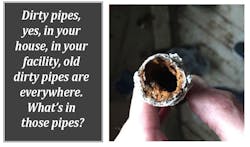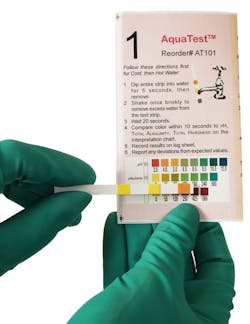Q
I am trying to find regulatory standards to determine what testing is required for water quality. How often should this be done in our Sterile Processing & Distribution (SPD) department (daily, weekly, monthly, etc.)?
A
Great question!
Consider this. If you ever go to a resort/hotel that has a swimming pool, they check the water quality a few times a day. I believe SPD departments should have a daily water quality monitoring program also, and here is why.
We know your processes require specific water quality specifications that improve the outcomes of the process the water interacts with, such as cleaning and steam sterilization.
Here are some documents that are perfect for this topic:
• TIR34:2014 (the water document)
• ST79
• ST90
• ST91
Due to copyright laws, I can only highlight sections of these documents. However, you can buy copies of them from the Association for the Advancement of Medical Instrumentation (AAMI) bookstore online at www.aami.org.
TIR34:2014
• Table 6 suggests types of testing, along with frequency and who should handle testing
• Table 7 lists reprocessing equipment to be tested, what to test for and frequency of testing
• Annex B goes in-depth into what should be monitored and how frequently
ST79, ST90, and ST91
These documents stress the importance of having a quality system in place within your department.
• In ST79, sections 3.2.2.2, 3.3.4.5 and 11.2.3
• In ST90, the introduction says it all. “This standard specifies requirements for a quality management system that can be used by an organization that processes medical devices.”
• Finally, in ST91, sections 5.7.3 and 5.7.4.2
These support documents help your department practice monitoring of water quality and daily testing of incoming water. Thus, you are ready for any potential problems.
One other document suggestion is your local Consumer Confidence Report (CCR). Each city must put out an annual drinking water quality report detailing where the water comes from (its source), what it contains, how it compares to the Environmental Protection Agency’s (EPA’s) and your specific state’s standards.
Why mention this? My municipality’s CCR warns yearly, “…when your water has been sitting for several hours, you can minimize the potential of lead exposure by flushing your tap for 30 seconds to two minutes before drinking or cooking. . . ” This official document will tell you the quality of the water entering your facility and it should be used as some baseline to understand how the water quality may change as it travels through pipes to your department. See pictures of actual water pipes and notice a new one to a pipe that has been is use for many years. The picture alone should make you want to test your water in some time frame.
There is a saying, “Forewarned is forearmed.” If you know about a problem or situation in advance, you will be able to better deal with it when you need to. Water quality is such a vital factor in our cleaning process. Daily monitoring of simple key factors like pH, hardness, alkalinity (and trending them over time), might be able to detect an issue before it becomes a problem.
• Assessment of water quality. Look at the instructions for use (IFU) for all your:
• cleaning chemistries
• cleaning equipment
• instrumentation
• Implementation of water treatment process
• Assurance of proper water quality for the various stages in medical device reprocessing
• Review the various standards and guidelines that support water quality monitoring
• Ongoing monitoring of water quality
• Put in a practical monitoring program
• Work with your Facilities department
• Cooperate with your various manufacturers that do water quality testing
• Daily testing of key indicators of water quality (water coming into your department) is vital
• Compare your tests to Facilities
• They test the water daily coming into your facility
• Issues could be found along the travel route of the water to your department
• Document your work, test results and actions
The main purpose of performing testing of water quality is to trend the values over time to help identify issues or process changes.
On a very positive closing note, TIR34 has not been updated since 2014 but the AAMI members realize water quality is an important factor. TIR34 will be replaced by AAMI ST108, which is presently being drafted. While unlikely to be published before next year, this new technical document will become the standard. Great news!
To “Keep Your Instruments Clean,” know the water quality at each stage of your reprocessing and sterilization cycle. Daily monitoring will help you do that.
References:
Grosse Pointe Woods 2020 Annual Drinking Water Quality Report (Consumer Confidence Report)
2017 Association for the Advancement of Medical Instrumentation • ANSI/AAMI ST79:2017
2017 Association for the Advancement of Medical Instrumentation • ANSI/AAMI ST90:2017
2015 Association for the Advancement of Medical Instrumentation • AAMI ST91:2015
About the Author

Stephen M. Kovach
Stephen M Kovach, BS, CFER, started in the medical field in 1975 as a sterilization orderly and has worked in many positions within the Healthcare Industry. He presently is Clinical Educator Emeritus at Healthmark, A Getinge company.


